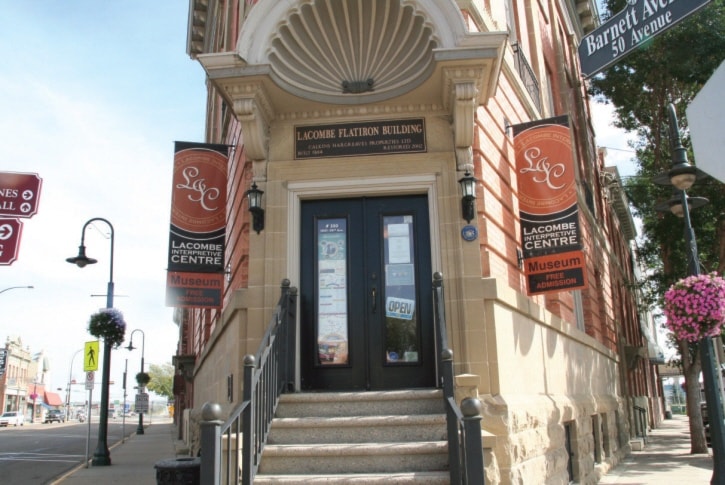BY ANNA MARIE JUNUS
Special to the Express
Keeping your money under a mattress, hidden in a floorboard, or tucked away in a jar was not uncommon for the early settlers of Lacombe, especially with reports of bank robberies throughout North America. The Merchants Bank of Canada, established in Lacombe in 1901, and the first bank in Lacombe, wanted to change that. They were conducting business in a rented room in a school house and also in the Victoria Hotel. They knew that to convince people to trust them with their money they would have to offer something that the settlers didn’t have and something better than a school room and a space in a hotel. Hogle and Davis, a pair of architects who had designed other Merchant Banks, were brought in and given the shape of the plot, due to the grid system that the town had adopted by creating streets perpendicular to the railway tracks; they designed the Flatiron building, fashioned after the famous Fuller building in New York City.
The Flatiron, a distinctive landmark in Lacombe, was built out of bricks and sandstone in 1904. As an example of Edwardian Classical Revivalist architecture, it conveys a more masculine, solid and stable appearance than the previously popular Victorian buildings. Narrowing columns and windows give the appearance of height. An ornate scallop-shaped hood over the doorway, mosaic tile floors and extensive woodwork throughout the building offered an image of power and wealth. What better place than this to store your precious earnings? And it worked. People began trusting banks. It’s no wonder that many financial institutions built around this time feature the same neo-classic styling.
Two years later, the other buildings on the Flatiron block, all constructed of wood, burned to the ground. The Flatiron was undamaged. Because of this, the town passed a bylaw that all future construction in the downtown area would be made of brick and sandstone. As each building was reconstructed, many not only used brick, but followed the Edwardian architecture of the Flatiron. One could say, that the reason the downtown core of Lacombe looks the way it does, is because of fire. It also provided a booming business for the local brickyards.
In 1922, in spite of its impressive appearance, the Merchants Bank of Canada went bankrupt and the Bank of Montreal bought the building and called it home until 1967 when it was purchased by Dr. McKibbon who made extensive changes to the building, renovating it for medical offices. The front door was lowered to the ground to enable his patients easier access. A spiral staircase led to upper floor apartments. The main floor vault was removed to make room for x-ray equipment, although the basement vault still remains. Later he joined forces with another medical practitioner who had bought the building next door. They punched a doorway between the two structures.
Later the building housed other businesses including an antique store and a photo studio.
It was purchased in 2001 by local business owners for a reported $165,000. Several hundred thousand dollars more was poured into the building to return it to its former appearance.
The front entrance was raised back to where it was. The inside was gutted and refurbished. Doors and windows were replaced and the exterior was reconstructed. It was discovered then that the windows were narrower at the top than at the bottom which required windows to be specially made.
On May 16, 2003, then Mayor, Judy Gordon cut the ribbon and officially opened the doors of the refurbished building. It now housed the Lacombe & District Historical Society Interpretive Centre on the main and basement floors, Tim Horton offices on the second floor, and an apartment on the top floor.
In 2008 the Lacombe and District Historical Society closed its doors to the Flatiron for a brief time until they were able to obtain funding. In only a matter of months, the doors were open again and the Society has been going strong, offering various displays throughout the years. Last year the displays focused on The Girl Guides of Canada, The Lacombe Police Service, local dairy farming, a Christmas Village, and winter sports. This past year the Flatiron had an exhibit of the Gull Lake Centennial and is currently showcasing quilts from local artists.
Throughout the years the Flatiron has been an important landmark in the City of Lacombe. No building in the City is allowed to be taller. It was featured in the 2005 movie The Magic of Ordinary Days. It is the older of only two flatirons in Alberta; the other is in Edmonton and known as the Gibson Block. There are only nine flatiron buildings in all of Canada. Any newspaper or magazine story about Lacombe features the Flatiron. The Flatiron has also been the site of the town water pump and a red light which alerted the local police to emergency calls.
With the sound construction of the Flatiron, residents can expect to see it standing strong for the next 100 years.
